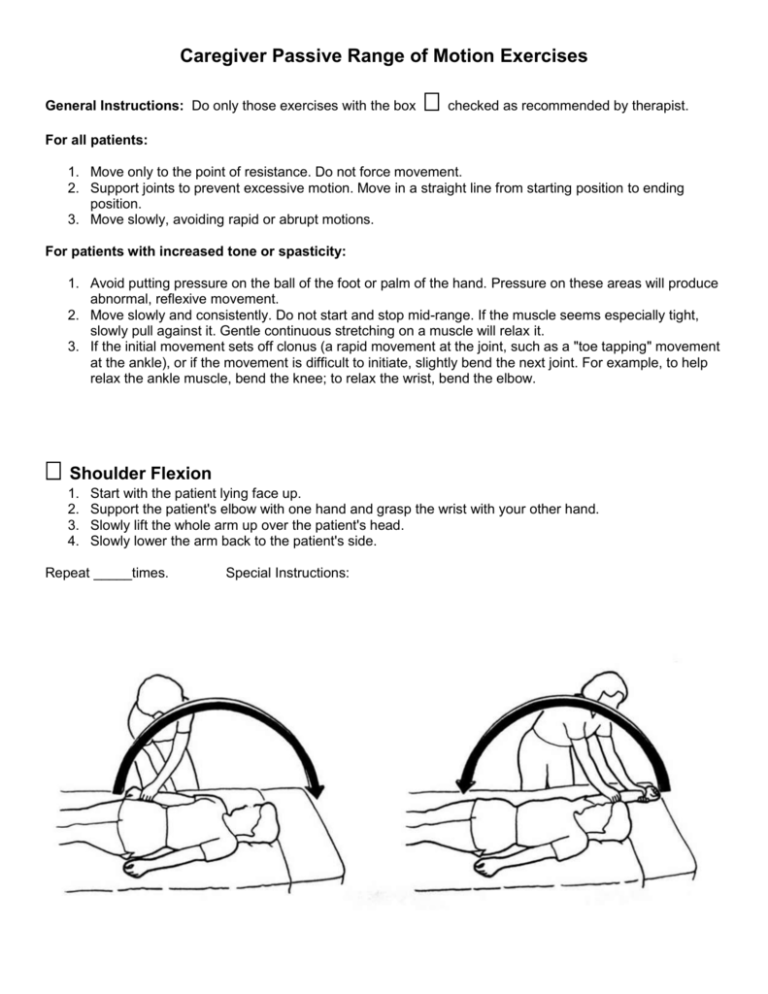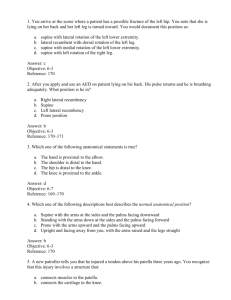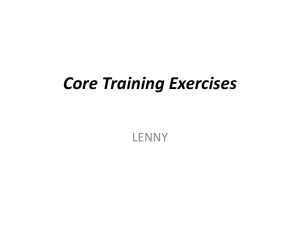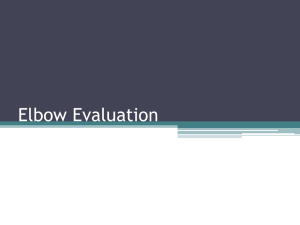Caregiver Passive Range of Motion Exercises
advertisement

Caregiver Passive Range of Motion Exercises General Instructions: Do only those exercises with the box checked as recommended by therapist. For all patients: 1. Move only to the point of resistance. Do not force movement. 2. Support joints to prevent excessive motion. Move in a straight line from starting position to ending position. 3. Move slowly, avoiding rapid or abrupt motions. For patients with increased tone or spasticity: 1. Avoid putting pressure on the ball of the foot or palm of the hand. Pressure on these areas will produce abnormal, reflexive movement. 2. Move slowly and consistently. Do not start and stop mid-range. If the muscle seems especially tight, slowly pull against it. Gentle continuous stretching on a muscle will relax it. 3. If the initial movement sets off clonus (a rapid movement at the joint, such as a "toe tapping" movement at the ankle), or if the movement is difficult to initiate, slightly bend the next joint. For example, to help relax the ankle muscle, bend the knee; to relax the wrist, bend the elbow. Shoulder Flexion 1. 2. 3. 4. Start with the patient lying face up. Support the patient's elbow with one hand and grasp the wrist with your other hand. Slowly lift the whole arm up over the patient's head. Slowly lower the arm back to the patient's side. Repeat _____times. Special Instructions: Shoulder Abduction/Adduction 1. 2. 3. 4. Start with the patient lying face up. Support the patient's elbow with one hand and grasp the wrist and hand with your other hand. Keeping the elbow straight, move the arm out to the side away from the patient's body. Move the arm up toward the patient's ear, keeping the elbow straight. Repeat _____times. Special Instructions: Horizontal Adduction/Abduction 1. Start with the patient lying face up. 2. Beginning with the right arm, support the patient's elbow with one hand, and grasp the wrist and hand with your other hand. 3. Bring the arm across the patient's body toward the opposite shoulder, keeping it straight 4. Repeat the procedure for the left arm. Repeat _____times. Special Instructions: Internal / External Rotation 1. 2. 3. 4. 5. Start with the patient lying face up, arm at a right angle to the body. Bend the patient's elbow 90 degrees, so the hand points up at the ceiling. Support the patient's wrist and hand with one hand, and hold the elbow with your other hand. Gently rotate the patient's hand down toward the feet, and then up toward the head. Repeat on the patient's other side. Repeat _____times. Special Instructions: Elbow Flexion and Extension 1. Start with the patient lying face up, one arm straight and lying beside the body. 2. Support the patient's elbow with one hand and grip the wrist and hand with your other hand. 3. Bend the patient's elbow, bringing the arm up to the point of resistance. 4. Slowly straighten the elbow and return to the starting position. 5. Repeat _____times. Special Instructions: Finger Flexion / Extension 1. Start with the patient lying face up. 2. Fold the patient's fingers into a fist. 3. Straighten out the patient's fingers and spread them apart. Repeat _____times. Special Instructions: Supination / Pronation 1. 2. 3. 4. Start with the patient lying face up, one arm at a right angle to the body. Bend the patient's elbow 90 degrees. Support the patient's elbow and grasp the wrist with your index finger and thumb. Twist the patient's hand so that the palm moves toward the patient's face, then away from it. Repeat _____times. Special Instructions: Wrist Flexion/Extension 1. Start with the patient lying face up, one arm at a right angle to the body. 2. Grasp the patient's forearm with one hand and the patient's hand with your other hand. 3. Move the patient's hand back and forth, bending the wrist. Repeat _____times. Special Instructions: Hip Flexion/Extension 1. 2. 3. 4. Start with the patient lying face up. Place one hand under the patient's knee and the other under the patient's heel. Move the whole leg up toward the patient's chest, bending it at the hip and knee. Return the patient's leg to the straight position. Repeat _____times. Special Instructions: Hip Abduction/Adduction 1. 2. 3. 4. Start with the patient lying face up. Place one hand under the patient's knee, and the other under the patient's heel. Keeping the patient's leg straight, pull it away from the midline of the body until you feel resistance. Move the patient's leg back to midline. Repeat _____times. Special Instructions: Dorsiflexion / Plantarflexion 1. 2. 3. 4. Start with the patient lying face up. Grasp both edges of the patient's foot, below the ball of the foot. Pull the patient's foot back so the toes are pointing toward the ceiling. Push the patient's foot down so the toes are pointing toward the wall. Repeat _____times. Special Instructions: Toe Flexion/Extension 1. 2. 3. 4. Start with the patient lying face up. Support the patient's foot near the ankle with one hand. Place the palm of your other hand on the patient's toes and curl them down toward the heel. Place your palm underneath the patient's toes, and push them up toward the knee. Repeat _____times. Special Instructions: Foot Inversion/Eversion 1. 2. 3. 4. Start with the patient lying face up. Grasp both sides of the patient's foot with your hands. Push down on one side while pulling up on the other. Reverse the motion. Repeat _____times. Special Instructions: Hip Extension, Side Lying 1. 2. 3. 4. 5. 6. Start with the patient lying face to the wall. Place one of your hands under the patient's calf to support the leg. Place the other hand on the patient's pelvis. Bend the patient's leg slightly at the knee. Push the patient's leg backward toward the buttocks until you meet resistance. Make sure the patient's body stays forward and only the leg moves back. Repeat _____times. Special Instructions: Shoulder Hyperextension, Side Lying 1. 2. 3. 4. 5. Start with the patient lying face to the wall. Place one of your hands under the patient's forearm below the elbow. Place the other hand on top of the patient's shoulder. Bend the patient's elbow 90 degrees. Keeping the patient's elbow bent, push the arm back until you meet resistance. Repeat _____times. Special Instructions: Trunk Rotation, Side Lying 1. 2. 3. 4. 5. Start with the patient lying face to the wall. Place one of your hands on the patient's shoulder. Place the other hand on the patient's hip. Pull the patient's shoulder toward you, and push the hip away from you. Reverse the action, pushing the patient's shoulder away and pulling the hip toward you. Repeat _____times. Special Instructions: Trunk Extension 1. 2. 3. 4. Start with the patient lying face up, with arms folded across the chest. Fold a bed sheet lengthwise twice, to a width of about eight inches. Slide the sheet under the patient's lower back area. Stand above the patient with your feet on either side of the patient's pelvis, and your knees slightly bent. Hold one end of the sheet in each hand. 5. Gently pull up on the sheet, lifting the patient's back two or three inches off the mat. 6. Lift the patient by straightening your knees and pointing your toes. Do not try to lift with your back. 7. Lift only as far as comfortable for the patient. Repeat _____times. Special Instructions: Trunk Rotation, Back Lying 1. Start with the patient lying face up, with arms relaxed at the sides. 2. Bend the patient's legs at the hips and knees, and place the feet flat on the bed or supporting surface. 3. Grasp the patient's knees and slowly move them from side to side, going only to the point of resistance. Repeat _____times. Special Instructions: Hamstring Stretch 1. 2. 3. 4. 5. 6. 7. 8. 9. Start with the patient lying face up, with legs straight. Kneel beside the patient's leg and place one hand under the ankle. Place your other hand on top of the patient's knee. Lift the patient's leg straight into the air, and reposition yourself to place the ankle on your shoulder. Place both hands on top of the patient's knee. Lean forward to lift the patient's leg higher into a stretch. Stretch the patient's leg until you meet with resistance, or the patient complains of pain. Hold for 10 seconds, then lower the patient's leg and relax. Do the same for the other leg. Repeat _____times. Special Instructions:








